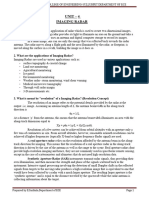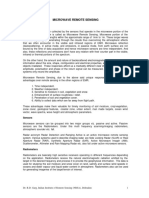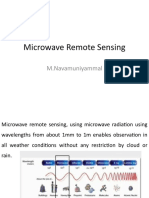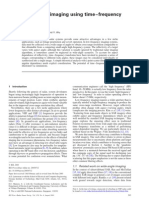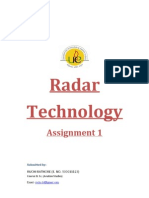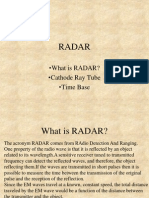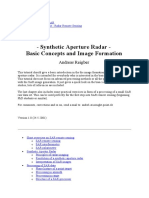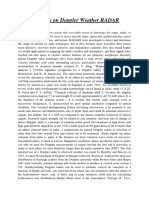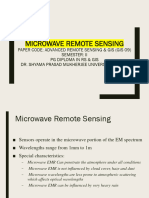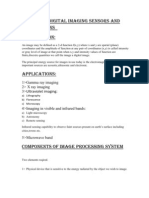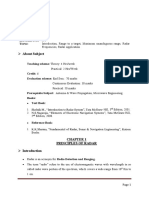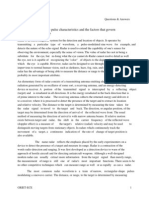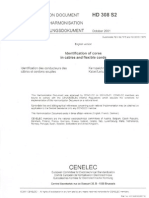3-5 Development of Airborne High-Resolution Multi-Parameter Imaging Radar SAR, Pi-SAR
3-5 Development of Airborne High-Resolution Multi-Parameter Imaging Radar SAR, Pi-SAR
Uploaded by
vinsenOriginal Description:
Original Title
Copyright
Available Formats
Share this document
Did you find this document useful?
Is this content inappropriate?
Report this DocumentCopyright:
Available Formats
3-5 Development of Airborne High-Resolution Multi-Parameter Imaging Radar SAR, Pi-SAR
3-5 Development of Airborne High-Resolution Multi-Parameter Imaging Radar SAR, Pi-SAR
Uploaded by
vinsenCopyright:
Available Formats
3-5 Development of Airborne high-resolution
multi-parameter imaging radar SAR, Pi-SAR
UMEHARA Toshihiko, URATSUKA Seiho, KOBAYASHI Tatsuharu,
SATAKE Makoto, NADAI Akitsugu, MAENO Hideo, MASUKO Harunobu, and
SHIMADA Masanobu
The airborne X/L-band Synthetic Aperture Radar system (Polarimetric and Interfero-
metric SAR, Pi-SAR) was developed by the Communications Research Laboratory and
National Space Development Agency of Japan in their joint project from 1993 to 1996. The
resolution of the X-band image is about 1.5 m and L-band is about 3.0m. Both SARs can
make fully polarimetric observations. The X-band SAR has a cross-track interferometric
function that measures the ground height with accuracy of 2 m. These systems are installed
in the airplane, Gulfstream . In this paper we describe our Pi-SAR system and the ground
processing system. In addition, we also discuss the performance of our system by using
the Pi-SAR datad.
Keywords
Synthetic Aperture Radar(SAR), High-resolution, Polarimetry, Interferometry, Dual fre-
quency
1 Introduction images at any time of day or night, and even
under adverse conditions like cloud covers. In
In recent years, the global environment addition, SAR can identify objects in a man-
issues have been drawing greater attention ner different from that of optical sensors, as
worldwide. In this context, remote sensing light and microwaves show different behav-
technology is expected to contribute to the iors in scattering and reflection. SAR has
monitoring of desertification and observations already been mounted on satellites and used in
of volcanic eruptions, earthquakes, and forest military applications. When mounted on an
fires. Radio waves are useful in such observa- airplane, SAR provides diverse observation
tions in that they are not affected by weather opportunities where parameters such as reso-
conditions and in that they allow observation lution, observation range, and incident angle
on a 24-hour basis. Synthetic aperture radar are optimized for each observation purpose.
(SAR), one type of microwave remote sensor, Although observation width becomes narrow,
transmits microwaves from an airplane or a an airborne SAR can obtain a high-resolution
satellite, receives the echoes returned from the image with 10 times the resolution as this
ground surface. This radar system can attain image taken from a satellite-borne SAR.
significantly high resolution through the use Further, improved hardware will make cut-
of advanced signal processing such as aperture ting-edge observation functions available for
synthesizing and pulse compression. The application experiments. While a satellite-
images provided by SAR appear quite similar borne radar system acquires observation data
to monochrome aircraft photograph. More- once following virtually the same flight course
over, the SARs use of microwaves has the and direction, airplane-borne SAR can per-
advantage of rendering it capable of acquiring form quick observations in arbitrary directions
UMEHARA Toshihiko et al. 109
and, in the event of a disaster, for example, it cross-track direction either to the left or right
can provide observations every day or multi- side of the advancing direction. If the pulse
ple times in one day. width is narrowed, the resolution in the range
Since 1993 the Communications Research direction is increased, but the S/N (signal-to-
Laboratory and the National Space Develop- noise) ratio declines as the transmission power
ment Agency of Japan have been jointly becomes low. Meanwhile, since the azimuth
developing an airborne three-dimensional resolution is determined by the beam width,
high-resolution X- and L-band imaging radar the beam width spreads in proportion to the
(Pi-SAR: Polarimetric and Interferometric flight height and the resolution declines
SAR) and carrying out a number of related accordingly. In order to maintain resolution
experiments. Designed not only for experi- levels in flights at high altitudes, the beam
mental purposes but also for practical use, this should be narrowed in the azimuth direction;
radar system is installed in a small jet and is thus, a large antenna will be required. Indeed,
capable of measuring the ground surface one imaging radar we previously developed
under the left side of the plane at a width of up featured an antenna aperture of about 3.5 m [1],
to 40 km, from an altitude of approximately so as to maintain a resolution of about 60 m at
40,000 feet (12,000 m). Pi-SAR is a multi- an altitude of 3,000 m at an incidence angle of
functional, high-performance radar system, 60 degrees.
featuring innovative interferometric and In contrast to this approach, movement in
polarimetric observation functions. This the azimuth direction can be used to synthe-
paper describes the Pi-SAR system, its data size an equivalent array antenna in a technique
processing system and data processing steps, called synthetic aperture radar (SAR) as
and provides an evaluation of its capabilities described next.
based on the obtained observation results.
2 Principles of Imaging Radar and
Synthetic Aperture Radar
2.1 Microwave Imaging Radar
Microwave imaging radar transmits radio
pulses downward and slantly in a direction,
normal to the advancing direction of an air-
craft or satellite, and receives the echoes
returned from the ground as shown in Fig.1.
Since the time a pulse takes to return home is
proportional to the distance to the ground, the Fig.1 Principle of microwave imaging radar
received pulses provide a scattering profile of
the ground perpendicular to the advancing 2.2 Synthetic Aperture Radar (SAR)
direction of the radar. As the radar proceeds When focusing on a single target, for
in the azimuth direction, it provides two- example, with moving radar having a relative-
dimensional ground images. The image reso- ly broad beam in the azimuth direction, a tar-
lution in the range direction is determined by get continues to receive the beam for the
the pulse width of the radar, while the azimuth entire period during which the plane flies from
resolution is determined by the antenna beam position 1 to position 3, as shown in Fig.2. In
width in the azimuth direction. In general, the other words, this is equivalent to using an
imaging radar adopts an antenna with a fan antenna with an aperture substantially as large
beam type pattern that is very sharp in the as L, or using an array antenna whose ele-
azimuth direction and relatively wide in the ments are extended from positions 1 to 3
110 Journal of the Communications Research Laboratory Vol.49 No.2 2002
along the flight course to receive the returned
signals.
By synthesizing the signals received from
such a virtual array antenna, the azimuth
resolution can be narrowed down to half the
real antenna aperture, regardless of flight alti-
tude. Namely, if the S/N ratio is not taken into
account, we can say that the smaller the anten-
na, the higher the resolution. On the other
hand, pulse-compression technology is adopt-
ed to raise the range resolution. Specifically, Fig.2 Basic concept of azimuth compression
FM chirp compression is usually adopted in
SAR. FM chirp compression is a technique by
which FM-modulated long pulses are trans-
mitted and received by a matched filter with
inverted frequency-delay characteristics to
convert the original pulses into narrow ones of
a larger power (Fig.3). Looking at this sort of
aperture synthesis in a different way, it may be
seen as a signal-processing method that uses
an appropriate matched filter to capitalize on
the fact that the Doppler effect (caused by the
planes movement against the ground) pro-
vides the same phase change as that resulting Fig.3 Basic concept of chirp compression
from FM modulation. In this sense, the
process of aperture synthesis is referred to as ty in integral multiples of 2. Therefore, if
azimuth compression. the phase difference between the signals
For such range compression and azimuth received by the two antennas is measured with
compression, we must acquire signal wave- high precision, Equation (1) provides the inci-
form data, including phase information as well dence angle,, at each point on the ground,
as signal intensity, using a receiver. As a while Equation (2) provides h[4].
result, the radar system becomes quite com-
plex, relative to real aperture radar, and the (1)
required recording and processing data
increases significantly in size. At the same (2)
time, the system features excellent resolution whereis wavelength, B is the baseline length
and a new function enabling the utilization of between two antennas,is the angle made
phase information. In short, the capabilities of between the baseline and horizontal line, H is
interferometric and polarimetric observations the altitude of the platform, and R is the range
create a distinctive advantage when perform- distance.
ing observations of the ground surface[2][3]. (2) Polarimetry
(1) Interferometry Polarization is the trajectory of the electric
When two antennas are installed in the field vector, a trajectory that changes along
cross-track direction, as shown in Fig.4, the with time at different points in space. Usually
phase difference between signals captured by such polarization is elliptical, but in some
the two antennas is determined by the differ- cases it may be circular or linear. If each of
ence in distance from each antenna to the tar- the transmitter and receiver antennas of the
get, although this difference includes instabili- radar has the function of transmission and
UMEHARA Toshihiko et al. 111
scattering matrix is made of complex numbers
carrying the phase-relation information, the
scattering (in elliptical polarization) from a
target irradiated by polarized waves can be
calculated by integrating those polarization
components. In other words, all of the infor-
mation related to polarimetry, including the
backscattering coefficient, can be determined
from the relations between these components,
as each features a complex amplitude,
although the scattering matrix features only
four-fold information. This is an essential fea-
ture of polarimetry.
Fig.4 Schematic description of height meas-
urement (Inferometry) 3 Pi-SAR System
reception both horizontally and vertically Airborne three-dimensional high-resolu-
polarized orthogonal waves almost simultane- tion imaging radar (Pi-SAR) is a radar system
ously, a scattering matrix is provided that has developed jointly by the Communications
four components combining the two (vertical Research Laboratory and the National Space
and horizontal) polarization components in Development Agency of Japan; this system
both transmission and reception. When the enables observation of the ground surface
Table 1 System parameter and performance
112 Journal of the Communications Research Laboratory Vol.49 No.2 2002
using dual frequencies simultaneouslythe X- The system for the L-band can be
band (with a wavelength of 3.14 cm) and the described with almost the same block diagram
L-band (with a wavelength of 23.6 cm). The as that for the X-band, except that it has no
horizontal resolution is 1.5 m in the X-band sub-antenna and only one data recorder.
and 3 m in the L-band, and Pi-SAR is capable These systems are deployed together on a two-
of polarimetric observations (by transmitting/ engine jet, the GulfStreamII. This airplane
receiving horizontally and vertically polarized allows observation at high altitudes (typically
waves) using either band. Pi-SAR also fea- 12,000 m) and at speeds of 220 m/s during
tures an interferometric function to provide observation[6].
elevation profiles of the ground using two
antennas through X-band observation. Table 1 3.1 Antenna Subsystem
shows the major specifications of Pi-SAR[5]. For the polarimetric function, the X-band
As shown in the block diagram in Fig.5, the main-antenna is equipped to deal with both
transmission signals (100 MHz in the X-band vertical and horizontal polarized waves. The
or 50 MHz in the L-band) are fed to the anten- sub-antenna, which is required for interferom-
na in the form of chirp signals and then irradi- etry, employs vertically polarized waves, as
ated to the ground. The radio waves reflected the return power of these waves is relatively
off of the ground are received by the antennas large. As indicated by Equation (4), the phase
and subjected to A/D conversion in the receiv- change grows in proportion to the distance
er (with phase information maintained), after (the length of baseline) between the main and
appropriate adjustment of receiver gain and sub antennas and the measurement accuracy in
other parameters. This data is saved in a data the ground height is improved accordingly.
recorder along with supplemental data, includ- The two antennas should be firmly installed as
ing airplane attitude. The data recorded in far apart as possible, as fluctuations in the
tape media is instantaneously read out by a antenna position caused by airplane vibration
reading-head and then sent to a real-time result in measurement errors. When these
processor. The real-time processor carries out were installed as shown in Fig.6, antenna sep-
necessary processing on the X- and L-band aration was 2.3 m in this Pi-SAR configura-
polarization data and visualizes the obtained tion. Considering the gain and redome size,
image on a screen. we determined the antenna dimensions as 19
Fig.5 Block diagram of X-band radar
UMEHARA Toshihiko et al. 113
cm (6) in the vertical direction and 105 cm feeder on the panel had a multi-layered struc-
(30) in the horizontal direction. The width ture adopting a dielectric honeycomb material
of the pencil-like beam in the azimuth direc- to provide a lightweight, highly rigid antenna
tion was about 2.5 degrees. Furthermore, we sub-panel. The antenna tilt angle in the eleva-
formed a square-cosecant type fan-beam elim- tion direction was 38 degrees so as to maintain
inating the change in received power so that power within the 10-dB range over about 40
the received power became almost constant, (22 to 58) degrees. Fig.6 shows the external
regardless of distance to the target in the ele- view of the antennas installed underside of the
vation direction. To be specific, the received airplane.
power fell within the -10 dB range over The redome had a sandwich structure
approximately 40 degrees. The antenna had a made of glass fabrics and epoxy resin, which
structure consisting of eight sub-array ele- materials are transparent to radio waves. The
ments arranged at intervals of 1/2 across the signal attenuation caused by the redome was
center so as to provide phase coherence on the around 0.1 dB. The redome for the X-band
radiation device during the 100-MHz sweep. system was 45 cm in diameter, where the
The roll angle was variable between 40 and 65 minor-axis aperture diameters of the vertical
degrees (peak to peak) to extend the range of and horizontal antennas were 20 cm and the
incidence angle selectivity for all target yaw angle was variable. The L-band system
objects and observation modes. The dual-axis was mounted directly on the body of the air-
variable angle (within 6.5 degrees) mecha- plane in order to reduce air resistance.
nism controlled the yaw angle so that the
antennas were kept parallel to the traveling 3.2 Transmitter Subsystem
direction, regardless of the drift angle of the An oscillator having a basic frequency of
airplane. 12.34 MHz provides eight frequencies to be
used inside the transmitter. A reference signal
is created with a highly stabilized quartz oscil-
lator using a quartz crystal under controlled
temperatures for optimally stabilized opera-
tion; indeed, a frequency stability of 10 -10
rms/sec is ensured for a short term. A chirp
signal is created in the chirp generator by
reading out (with the reference trigger) the
waveform data saved in EPROM (12 bit digi-
tal data). Then, this is added to intermediate
frequency and transferred to the radio frequen-
cy (either 9.55 GHz or 1.27 GHz).
Fig.6 An airplane instal led SAR The high-output amplifier for the X-band
is made of a traveling wave tube (TWT) so as
Since L-band waves are longer in wave- to maintain stability and reduce frequency-
length than X-band waves, the antenna must dependent fluctuations in the output level.
be larger. We adopted a micro-strip antenna This amplifier can provide an output power of
that enabled transmission and reception of about 6 kW at the antenna end. Meanwhile, a
both horizontal and vertical polarization transistor-type high-power amplifier provides
waves with a single antenna. The patch ele- an output of 3 kW for the L-band. The ampli-
ment was square so as to cut off the cross- fied signal is supplied to either vertical or hor-
polar component of the linear orthogonal ver- izontal polarization antenna. Part of the
tical/horizontal polarization waves. The amplified signal, branched with a coupler, is
mounting unit for the antenna elements and used to monitor transmission power and to
114 Journal of the Communications Research Laboratory Vol.49 No.2 2002
correct fluctuation. 3.4 Control and Signal Processing Unit
In addition to independent observation, it This system aims to identify the target
is possible to use the L-band to determine objects based on phase information. Thus all
which transmission and reception timings are the signal processing units are required to
synchronized with the reference frequency work in synchronization. For this purpose, all
provided by the X-band system. Low-resolu- the hardware is controlled by the reference
tion (10 m and 20 m) modes are also available signal provided by the frequency generator.
for simulation of the synthetic aperture radar Further, X-band and L-band observations are
system (ALOS/PALSAR) that will be mount- synchronized by supplying the X-side 1-MHz
ed on a satellite scheduled to be launched in and 123-MHz clocks to the L-side.
2004. Airplanes are subject to attitude fluctua-
tions of shorter intervals than those of satel-
3.3 Receiver Subsystem lites. The synthetic aperture radar mounted on
The receiver system has two channels (1 an aircraft, therefore, requires as much real-
and 2) of the same structure so as to receive time aircraft attitude data as possible. For this
vertical waves and horizontal waves at the purpose, our system is equipped with high-
same time and to enable it to handle two precision sensor systems such as an inertial
polarized waves separately, to perform the navigation system (INS) and a GPS to provide
polarimetric function both in the X and L information about position and attitude. This
bands. In short, Channel 1 handles the verti- information is collected by the signal-process-
cal polarization signal, while Channel 2 han- ing unit and saved in a data recorder along
dles the horizontal polarization signal. How- with I and Q data obtained by the receiver.
ever, in order to perform interferometry and One of the benefits of the synthetic aper-
polarimetry at the same time in X-band obser- ture radar lies in its generation of large quanti-
vation, Channel 1 features a mode in which it ties of data. Approximately three minutes of s
switches the horizontally polarized wave of in a flight of experiment produces about 12
the main antenna and the vertically polarized GB of X-band data and 6 GB of L-band data.
wave of the sub-antenna alternately for each For data storage, we have adopted two high-
pulse, as well as another mode in which it speed data recorders (DIR-1000) for X-band
handles only the sub-antenna signals for inter- data storage and one DIR-1000 for L-band
ferometry alone. When this mode adopted by data storage. The data transmission rate of
Channel 1, Channel 2 handles only the verti- this type recorder is 256 Mbps per unit. Each
cally polarized wave of the primary antenna. cassette has a large data capacity of 90 GB per
Received signals in the two channels pass cassette; however, this is used within about 50
a limiter and a bandpass filter and then enter minutes of continuous observation.
the first stage low-noise amplifier a FET
amplifier capable of reducing the noise level 3.5 Real Time Processor
to 3 dB or lower. After a frequency conver- The airborne SAR is distinguished by its
sion in the gain control unit, the signals pass rapid availability in the event of a disaster, and
sensitive time control (STC) and auto gain can be used to gather information on a real-
control (AGC) units. Finally, the signals are time basis during a disaster. To meet the
divided into two components, (I,Q), having requirements related to such applications, a
phase angles 90 degrees apart and detected as real time processor was installed in the SAR
such so that complex signals having phase in 2000. This device can reproduce and
information can be obtained. Each of these process arbitrary X- and L-band polarimetric
signal components is passed through an A/D data acquired in observation to provide an ini-
converter to become digital data. tial overview. The number of data acquisition
points, however, is fixed at 1,024 in the range
UMEHARA Toshihiko et al. 115
direction, due to limitations of data size and Further, in mountainous areas, the flight alti-
processing rate, and its bandwidth changes tude of the aircraft becomes substantially
with resolution (max. 2.5 m). Table 2 lists the lower due to the effect of ground height. In
parameter settings, selectable via a switch. such cases the slant range shifts from the cor-
When reading out the data written on the tape rect value and the target may go out of the
in the recorder and transferring the readout observation range. We must take these factors
data to the real time processor, it is possible to into account when determining observation
check to determine whether or not the written parameters. In addition, when measuring
data is correct. The processed image data is steep mountainous areas, we must determine
displayed on-screen, and image data for each the incidence angle so as not to cause fore-
page can be saved to a magneto-optical (MO) shortening or produce shadows on slopes. In
disk. this manner, a flight plan is designed to cover
about ten observation paths per day, to most
Table 2 Selective parameters for real time efficiently execute the required observation.
processing The aircraft on which the airborne SAR is
installed is capable of continuous flight at an
altitude of 12,000 m at about 220 m/s for about
four hours. This translates into a distance of
more than 3,000 km, which would appear
largely sufficient in terms of observation. In
fact, the net observation time is approximately
half of the above-mentioned maximum flight
time, as the observations require a certain lead
time for stabilization of airplane attitude
(including drift angle) before entering the
respective flight path, and the aircraft needs
time to ascend, descend, move between flight
paths, and turn around.
4 Observation Plan and Opera-
tion 4.2 Operation
When a proper observation plan is made,
4.1 Observation Plan the starting observation position, the observa-
The airborne SAR measures the area under tion mode, the observation distance, and the
the plane on its left side in a slanted direction parameter settings can be saved in a parameter
with a fixed width. We must determine the file before the flight of experiment. When
flight course in advance to most efficiently starting actual observations, we read out this
cover the target areas. For this purpose, the parameter file to establish the observation
latitude and longitude information for the tar- mode, saving time in preparations and pre-
get areas must be known prior to observation. venting erroneous parameter settings. On the
In addition, information about incidence day of observation, we first check the weather
angles is required, as the backscattering cross- conditions and the flight course and activate
section of a target depends on its incidence the INS and GPS before takeoff. Nitrogen is
angle. Particularly in X-band observation, the filled in the X-band wave guide under pres-
antenna roll angle is variable and is set at a sure to prevent discharge prior to takeoff.
value that will maximize the antenna gain over When approaching the observation site, the
the target observation area. For some targets, operator begins observation following the
the observation direction (direction of emitted steps listed on Table 3, based mainly on the
radio waves) is another important parameter. information provided by the pilot. When the
116 Journal of the Communications Research Laboratory Vol.49 No.2 2002
aircraft has arrived at the point at which
straight flight will begin, the pilot stabilizes 5 Data Processing Subsystem
the drift angle so as to maintain the flight
course and notifies the operator of the timing The higher the horizontal resolution
for commencement of observations. The becomes, the greater the amount of data
operator for X-band observation then makes acquired in SAR observation. Accordingly,
temporary settings for antenna roll angle and data readout and data processing will take
yaw angle to correct for drift angle. The oper- longer. Fortunately, the data processing speed
ator is then notified of the start timing and of processors and the capacity of storage
makes the appropriate settings for the observa- media have improved remarkably in recent
tion parameters. We set aside about 10 sec- years. We have continually upgraded the SAR
onds for averaging of the aircraft altitude and data processing system in step with such
drift angle. When the parameter setting have improvements. Described below is the system
been completed, the SAR system controls the status as of the end of 2001.
recorder and, when the tape is running
smoothly, begins observations after three sec- 5.1 Hardware
onds of noise observation and 15 seconds of Fig.7 presents configuration of the SAR
receiver calibration. Table 3 shows the rele- processing system.
vant timetable (indicating only the essential In this figure, SAR data processing com-
items for such settings). Operators are puter and SAR application processing comput-
absorbed in final verification of observation er are separated only for convenience; they do
parameters and hardware conditions during not each feature customized programs. Thus
observations. either computer may be used as backup for the
other, and their connections are configured to
Table 3 Operation flow (per observation enable both primary and backup functions.
path)
Raw data is read out to a D1 tape device con-
nected to the primary calculator via SCSI
interface and is subject to Level-0 processing
to arrive at a predetermined data format.
Since approximately five minutes of observa-
tion in the X-band provides 19 GB of data (at
maximum), a 180-GB HDD can only serve as
temporary storage. Thus we save data that has
been subject to Level-0 processing to a 180-
GB DTF tape. This basic data-processing sys-
tem is duplicated; thus, parallel processing is
possible.
After producing the Level-0 data, we
check the hardware and conduct browse pro-
cessing (10 m per pixel) for catalog prepara-
tion purposes. This processing is carried out
on data acquired from all flight paths, and
obtained data will be added to the catalog
information. Later, SAR images are
processed. The image size is 5 km5 km, and
approximately 1.5 hours is required for data
processing of one scene of single polarimetric
data. Data that has gone through basic pro-
UMEHARA Toshihiko et al. 117
at which point it is subject to higher-level data
processing, as necessary.
5.2 Software for data processing
SAR software can be divided into three
categories, depending on function, as follows:
(1) Level-0 data production;
(2) Image production; and
(3) Distributed data production
The contents of each process are described
below.
(1) Level-0 data production
Raw data recorded to the data tape during
the experiment flight is read out for the pro-
duction of Level-0 data. More specifically,
the main process consists of the separation of
received signals based on the types of polar-
ized waves and observation modes involved
(i.e., calibration, noise data, or actual observa-
tions). At the same time, a file is made of
flight information for each data frame; these
files will be required when performing motion
compensation and when referring to radar set-
tings during observation.
(2) Image production
The image production process is divided
into the following four steps, which feature
different data formats for output. Appendix-1
lists the formats for individual products, in
addition to other relevant items.
(a) Single-look slant-range complex image
production
In this step, as the central element of
image reproduction, range compression and
azimuth compression are performed, with cor-
rection of radar parameters and motion com-
pensation of the aircraft based on the received
signals. The received signals are visualized in
this process. This step will be explained in
more detail later.
(b) Multi-look ground-range amplitude image
production
Fig.7 Confinguration of SAR processing system The power of SSC data is calculated and
subjected to multi-look processing (4-look for
cessing such as single-look slant-range com- Pi-SAR) to perform conversion from slant-
plex (SSC) data and multi-look ground-range range data to ground-range data.
amplitude (MGA) data is saved to a hard disk (c) Multi-look ground-range polarimetric
in the file server and sent through the network, image production
118 Journal of the Communications Research Laboratory Vol.49 No.2 2002
SSC data is converted into the Muller range compression described in Section 2.2,
matrix and subject to multi-look processing. in a matched-filter process. In fact, this repre-
After calculation of the components in the sents a convolution calculation, using the
complex scattering matrix, slant-range to range reference function in the given frequen-
ground-range conversion is performed. cy region. With S ref (f) representing the
(d) Interferometric processing results of Fourier transform of the range refer-
In this calculation, phase difference is ence function, Srev (f) representing the Fourier
derived from the phase difference obtained transform of received waves, and W (f) repre-
with the main and sub antennas by removing senting the window function in the current fre-
phase difference from a plane. Further, coher- quency region,
ence between data sets is calculated to provide Src (f) = W (f) Srcv (f) S* ref (f)
multi-look slant-range interferometric images where * represents the complex conjugate
and multi-look slant-range coherence images number.
as output. The range compression signal is obtained by
In addition, the browse image produc- inverse Fourier transform of Src (f).
tion process is performed to check observa- (2) Radiometric correction
tion conditions, confirm the observation range, In addition to corrections related to the
and prepare catalog data. The size of browse receiver, the range-compressed signal under-
image is 20 km long in the range direction and goes transmitter level correction, antenna ele-
50 km long in the azimuth direction with one vation correction, and attenuation correction
pixel size being 10 m. (dependent on the propagation distance of the
(3) Preparation of materials for users radio waves).
In principle, the obtained data is com- (3) Aircraft motion compensation
pressed and recorded in CD-ROM and other Motions in height and attitude of the cause
media formats for easy distribution in this shifting and phase rotation in slant-range pix-
step. We have adopted JPLs SIR-C SLC els. Thus the influence of these motions
quad-pol data method for compression. This should be removed prior to azimuth compres-
method enables the compression of an original sion. If the motion-induced shifts in position
2,048 MB of data [for 4 ch-SSC images (8 of the transmission antenna [y: cross-track
bytes 4) for each 5 km 5 km area] to 10 direction (+: left), z: vertical direction (+:
bytes per pixel, to fit on a 640 MB CD. upward)] relative to the reference course of
the aircraft are expressed byytrans (y), ztrans
5.3 SSC Image Production (y), and if similarly, those of the reception
This section explains single-look slant- antenna are expressed byyrcv (y), zrcv (y),
range complex image production, which rep- the look angle is(), and the wavelength of
resents the core of the actual reproduction the adopted microwave is, then the slant-
process. range shift r (t,), and phase rotation (t,
(1) Range compression ) are expressed by:
I and Q data saved in the recorder consists
of power data sets containing information on
phases that are separated by 90 degrees. This
data is converted into complex numbers. We Among these correction quantities, the
correct the DC bias (zero level adjustment) positional information (derived by integrating
and gain for both the I and Q data sets in order the INS data that was recorded with the
to average fluctuations in the characteristics of received signals) is embedded in the inde-
A/D converters. Gain/phase changes in the pendent GPS positioning data. The attitude
receiver amplifiers and attenuators are also data is calculated by integrating the angular
corrected. The data is then subject to the acceleration detected by a gyro installed in the
UMEHARA Toshihiko et al. 119
INS. Transmission pulses must be resampled called migration correction. We convert the
with reference to this positional information. time-axis data into frequency-axis data and
Thus, based on this aircraft attitude data, calculate the movement at the same Doppler
resampling is carried out in order to maintain frequency so that all of the target information
phase information using a finite impulse is arrayed in the azimuth line.
response (FIR) filter with linear phase charac- (6) Azimuth compression
teristics. The filter length and sampling inter- This is a data processing operation by
val are variable. which the reference azimuth wave is created
(4) Estimate of center Doppler frequency from the center Doppler frequency and aver-
The center Doppler frequency is easily age speed of the aircraft followed by correla-
estimated, provided that the information about tion with signals that have experienced range
aircraft attitude and speed are precisely migration. This process is also a correlation
known. However, in most cases, it is difficult calculation in the adopted frequency region, as
to measure the aircraft attitude precisely. in the case of range compression. If Sref-az (f,)
Therefore, the Pi-SAR processing system is is the Fourier transform of the reference
using the positional information provided by azimuth wave, S'rc (f,) is that of the signal
the above-mentioned aircraft motion compen- subject to range migration and W (f) is the
sation, instead of estimating the center window function, then azimuth compression
Doppler frequency. signal can be provided by inverse Fourier
Nevertheless, it is also possible to conduct transform of a correlation calculation Sac (f,)
correction using the estimated center Doppler = W (f) S'rc (f,) S*ref-az (f,) where * repre-
frequency, as follows. First, the azimuth-line sents the complex conjugate number.
signal previously subject to range compression
is converted into the Doppler frequency region 6 Evaluation of the Pi-SAR System
to allow estimation of its power. We examine
the correlation between the estimated power (1) Resolution
and round-trip azimuth antenna pattern corre- In general, the resolution of a synthetic
sponding to the Doppler frequency, and deter- aperture radar is expressed by r = c/2B in the
mine the frequency that shows the peak of slant-range direction, as mentioned earlier,
such correlation. This frequency, however, where B is transmitter bandwidth. The
will feature uncertainty equivalent to an inte- azimuth resolution (single-look) is given by
gral multiple of the pulse-repetition frequency. Az = D/2, where D is the real antenna aperture
This instability is corrected based on the cen- length (usually around 1.2 times the real
ter Doppler frequency provided by the aircraft antenna length).
attitude correction. This value is estimated in The process used in general analysis is
several different range positions and is calcu- also used to perform multi-look so that the
lated by least-square interpolation. azimuth-direction resolution may become as
(5) Correction of range migration high as the range-direction resolution and
Considering the airplanes trajectory rela- thereby reduce speckle noise.
tive to a point on the ground, we can express In X-band resolution, when the transmitter
the slant-range distance by a quadratic equa- bandwidth is 100 MHz and the antenna length
tion that provides the shortest distance to the is 1.05 m, then r = 1.5 m and Az = 0.63 m,
target, i.e., when it is located to the immediate while in L-band resolution, when the transmit-
left of the plane. As a preliminary process ter bandwidth is 50 MHz and the antenna
prior to azimuth compression, we have to cor- length is 1.55 m, r = 3.0 m and Az = 0.93 m
rect the range distance (or arrange the dis- are expected. When evaluating the resolution
tances in a different sequence) within the of SAR, we need a point target in a location
adopted bandwidth. This correction process is where the background scattering level is low.
120 Journal of the Communications Research Laboratory Vol.49 No.2 2002
For this purpose, CRL conducted a calibration dB), which is well beyond the specified level
experiment by deploying corner reflectors at of -80 dB or less.
Tottori dune. Fig.8 shows the obtained cali- (3) Ground projection accuracy
bration data. This figure indicates that the In Pi-SAR data processing for data projec-
range resolution is approximately 1.5 m and tion in the ground-range direction, projection
that azimuth resolution is 0.83 m in X-band on the ground surface is carried out based on
resolution, while the range resolution is the slant-range information about flight height
approximately 2.9 m and azimuth resolution is and incidence angle at each observation site,
assuming that the ground elevation is uniform
in the area under observation. In order to
examine the pixel position in the ground-range
direction, we deployed several corner reflec-
tors over about 10 km in the range direction in
Ohgata village in Akita prefecture. We then
compared the determined positions of these
reflectors with the position data obtained by
GPS. We found that the ground-projection
Fig.8 Response from CR (X-band) accuracy declined in proportion to the magni-
tude of errors in flight height. When ground
1.2 m in L-band resolution; these results are in projection was carried out using the GPS sys-
near agreement with the design specifications. tem, the altitude error resulted in poor projec-
(2) Minimum receiving sensitivity tion accuracy. However, Pi-SAR can estimate
The SAR system conducts internal calibra- the altitude of the aircraft provided by interfer-
tion and noise data before and after each ometric processing. We found that ground
observation. The minimum receiving sensitiv- projection based on this estimated height
ity can be estimated from this data. The level information would provide positioning accura-
diagram indicates that the noise level, which is cy as high as approximately one pixel.
measured based on the power at the output ter- In other words, when the ground height
minal of the receiver, lies between -77 dB and changes within the produced image, a ground
-87 dB. Fig.9 presents sample calibration projection error occurs from elevation change,
data. This indicates that the input level is unless the ground height data for each pixel
almost linear in the region from approximately position is taken [7].
-88 dB. Thus the minimum receiving sensitiv- (4) Interferometry
ity is nearly equivalent to the noise level (-87 The error of interferometry is estimated by
equation (1), in which the altitude error is 3.2
m where a phase-measurement error is 5
degrees at an altitude of 12,000 m and at an
incidence angle of 45 degrees. In order to
evaluate the accuracy of altitude data in real
measurements, we conducted interferometry
processing on the observation data for Ohgata
village, Akita prefecture, and calculated alti-
tude for purposes of comparison. Ohgata vil-
lage, which was built on reclaimed land, fea-
tured almost no variations in ground elevation.
In addition, since the unit size of each paddy
was very large (90 m150 m), much larger
Fig.9 Input/output characteristics of the than Pi-SARs minimum area of resolution,
receiver
UMEHARA Toshihiko et al. 121
we were able to gather a sufficient quantity of data and the CRL Web page). The level of
data samples from a single paddy. Then we cross-talk in both the X- and L-band ones is so
calculated the average and standard deviation low that it may be ignored. Since a patch
of the data for several measurement points antenna is adopted in L-band observation, the
antenna position does not change between dif-
Table 4 Mean height and S.D. by inci- ferent polarization waves. On the other hand,
dence angles in Ohgata village in X-band observation, antennas in different
positions are used for each polarization wave
and the roll angle is variable. Thus a correc-
tion related to antenna position becomes nec-
essary to gain accurate phase information[9].
Furthermore, for precise polarimetric calibra-
tion, it would be helpful to conduct a calibra-
tion experiment in which we installed a num-
ber of such reference targets at different inci-
dence angles in the imaging area of interest.
featuring different incidence angles. The cal- Such an experiment, however, is not practical
culation results are listed in Table 4. to perform. Van Zyl et al. conducted calibra-
Note that at the time of interferometry pro- tions[10] for JPLs AIRSAR, using natural tar-
cessing 2 2 averaging was performed on gets as well as artificial ones. However, it is
both the azimuth and range directions, and difficult to find a natural scattering target in
pixel spacing was 2.5 m. Approximately 600 Japan that is uniform over a wide range; thus
pixels were used in this statistical treatment. we have been developing an alternative
The obtained results show that shallow inci- method of calibration.
dence angles result in higher sensitivity to
phase change and thus produce less error, and 7 Summary
that some averaging improves the ground
height accuracy. The required accuracy can be The observation result obtained until now
obtained by averaging over (5 m)2 - (10 m)2. shows that the development target was almost
(5) Polarimetry attained about the system by which the air-
Polarization is expressed by a scattering borne synthetic aperture radar together devel-
matrix composed of four complex numbers, as oped by Communications Research Laborato-
described earlier. It is necessary to measure as ry and National Space Development Agency
correctly as possible the absolute value of of Japan includes a data-processing function.
these elements, and the relation between ele- Calibration coefficients for the radar have also
ments. Thus external calibration, using been clarified through experiments employing
known targets, becomes necessary. In general, corner reflectors deployed at Tottori dune. As
we are required to estimate inter-channel we have added a real time processor unit to
imbalance (with respect to phase and power) the basic hardware system, it can now be
as well as to calculate the absolute values of adopted quickly and effectivelyin the event
the respective channels using corner reflectors of emergency, for example. The system has
(CR), and active radar calibrators (ARC). In been upgraded, whenever necessary, to
the case of Pi-SAR, we had conducted calibra- accommodate massive data processing tasks,
tions using CR and ARC installed in Tottori and modifications of the software have thus
dune and on ice in Saroma Lake [8] . Gain reached a satisfactory stage.
imbalances in the X- and L-band systems has The future challenges regarding hardware
been made public in the form of calibration include an exploration of the possibilities of
coefficients (see the handout CD of Pi-SAR along-track interferometry and real-time
122 Journal of the Communications Research Laboratory Vol.49 No.2 2002
downlink of data. In order to use the obtained data for various areas such as forests, farms,
Pi-SAR and other observation data more and oceans. We expect that more and more
effectively, we anticipate moving forward in researchers will become interested in the Pi-
collaboration with research institutions that SAR program and that synthetic aperture radar
are extensively involved in related applica- will be subject to further and more extensive
tions. In addition, we have distributed CD- investigation in the future.
ROMs to potential users that contain Pi-SAR
UMEHARA Toshihiko et al. 123
Appendix-1. Formats of the products
(1) Data products
Single-look Slant-range Complex: SSC
Processing
Range compression
Single-look azimuth compression
4-byte + 4-byte complex
SSC
Bandwidth Resolution [m] Pixel [m]
Az 1 Sr 1 Az 2 Sr
X-SAR 100MHz 0.375 1.5 0.261 1.214
50MHz 0.375 3.0 0.261 2.428
L-SAR 50MHz 0.750 3.0 0.522 2.428
1:
Theoretical value without any window function
2:
Nominal value (depends on airplane speed and PRF)
Multi-look Ground-range Amplitude: MGA
Processing
Multi-look processing of SSC data
Slant-range to ground-range conversion
Calculation to Amplitude
2-byte integer
Multi-look Ground-range Polarimetric: MGP
Processing
Calculate complex scattering matrix from SSC data
Transform to Muller matrix, multi-look processing and transform to scattering matrix
Slant-range to ground-range conversion
4-byte + 4-byte complex
MGA/MGP
Bandwidth Look number Resolution [m] Pixel [m]
Az 1 Gr 1 2 Az Gr
X-SAR 100MHz 4look 1.5 1.6-17.2 1.25 1.25
50MHz 8look 3.0 3.2-34.4 2.50 2.50
L-SAR 50MHz 4look 3.0 3.5-8.8 2.50 2.50
1:
Theoretical value without any window function
2:
Incidence angle of 20 to 60 degrees
Browse image
1-byte integer
Image swath 50 km (azimuth)20 km (range)
Resolution of about 10 m (range)10 m (azimuth)
(2) Data-file structure
The decompressed file has no header or the like. Instead, data sets are repeated as many times
as there are azimuth-direction data points along a single azimuth line.
Coordinates in the image
124 Journal of the Communications Research Laboratory Vol.49 No.2 2002
Azimuth direction
(1,1) ......... ( Nx , 1 )
: : Range direction
( 1 , Ny ) ......... ( Nx , Ny )
Nx: Data-point number in the azimuth direction
Ny: Data-point number in the range direction
(a) Data arrangement in each file of decompressed MGP data
Re ( 1 , 1 ) Im ( 1 , 1 ) ......... Re ( Nx , 1 ) Im ( Nx , 1 )
: : : :
Re ( 1 , Ny ) Im ( 1 , Ny ) ......... Re ( Nx , Ny ) Im ( Nx , Ny )
4-byte real 4-byte real
(b) Data arrangement in each file of decompressed power (VV-mode) data
Amp ( 1 , 1 ) ......... Amp ( Nx , 1 )
: :
Amp ( 1 , Ny ) ......... Amp ( Nx , Ny )
4-byte real
Decompressed data is of the following size:
(a) nnnn* (8-byte complex number data*mmmm)*4 polarized waves
(b) nnnn* (4-byte real number data*mmmm)
If nnnn = 4,000 and mmmm = 3,000, then the sizes are given by:
(a)4,000* (8*3,000)*4 = 384 MB, (b)4,000*4*3,000 = 48 MB.
(3) Reference information
The distributed data includes a reference information file that has "_a" at the end of the file name.
This includes observation information about altitude and airplane speed, latitude/longitude of the
processing site, incidence angle, pixel number, pixel size, and window function processing. You can
refer to this information file together with the JPEG data in this document. It may prove helpful for
reference when analyzing reproduced images.
References
1 T.Kozu, et al., "Researh on Compact and High-performance Airborne Imaging Radar for Wide-area
Monitoring of Oil Pollution ", Environment Preservation Reports, pp.84-1 to 84-12,1989.
2 F.T.Ulaby, R.K.Moore and A.K.Fung, "Microwave Remote Sensing active and passive ", Artech
House,Inc. MA,Vol.2,1982.
3 Curlander,J.C. and R. MacDonough, "Synthetic Aperture Radar: Systems and Signal Processing ",
John Willy & Sons, New York,1991.
4 Allen, C.T., "Interferometric Synthetic Aperture Radar ", IEEE Newsletter, Sep. 1995.
5 Development of Three-dimensional Airborne SAR at CRL, Tech.Rep.IEICE, SEAN95-99,33-38,1995.
6 T. Kobayashi, et al., "Airborne Dual-Frequency Polarimetric and Interferometric SAR", IEICE Trans.
Commun., Vol.E83-B, No.9, pp.1945-1954, 2000.
7 T.Umehara, et al. , "Accuracy validation of ground projection Pi-SAR images ", RSSJ, No31pp.267-
268,2001.
UMEHARA Toshihiko et al. 125
8 M. Satake, et al., "Calibration of an X-band Airborne Synthetic Aperture Radar with Active Radar
Calibrators and Corner Reflectors ", CEOS 1999 SAR Workshop, Toulouse, France, 1999.
9 M. Satake, et al., "Development and Experiment of Polarization Selective Corner Reflectors for
Polarimatric SAR Calibration ", 2001 CEOS SAR Workshop, Tokyo, Japan, 2001.
10 J.J.van Zyl, "Calibration of polarimetric radar images using only image parameters and trihedral cor-
ner reflectors ", IEEE Tans. Geoscience Remote Sensing, Vol.28, No3, pp.337-348,1990.
UMEHARA Toshihiko URATSUKA Seiho, Dr. Eng.
Senior Researcher, Environment Infor- Leader, Environment Information
mation Technology Group, Applied Technology Group, Applied Research
Research and Standards Division and Standards Division
Global Environment Remote Sensing Microwave Remote Sensing
KOBAYASHI Tatsuharu, Dr. Sci. SATAKE Makoto
Senior Researcher, Environment Infor- Senior Researcher, Environment Infor-
mation Technology Group, Applied mation Technology Group, Applied
Research and Standards Division Research and Standards Division
Remote Sensing by Microwave Microwave Remote Sensing
NADAI Akitsugu MAENO Hideo
Senior Researcher, Environment Infor- Senior Researcher, Environment Infor-
mation Technology Group, Applied mation Technology Group, Applied
Research and Standards Division Research and Standards Division
Physical Oceanography, Ocean Remote Pi-SAR, Remote Sensing
Sensing
MASUKO Harunobu, Dr. Sci. SHIMADA Masanobu, Ph. D.
Executive Director, Applied Research Senior Engineer, Earth Observation
and Standards Division Research Center, National Space
Microwave Remote Sensing Development Agency of Japan
Global Environment Remote Sensing
126 Journal of the Communications Research Laboratory Vol.49 No.2 2002
You might also like
- Dryer Service ManualDocument35 pagesDryer Service ManualReggie Byrum50% (2)
- Synthetic Aperture Radar Signal Processing Technique For Target Image GenerationDocument4 pagesSynthetic Aperture Radar Signal Processing Technique For Target Image GenerationVarun GangwarNo ratings yet
- RS Unit 4Document11 pagesRS Unit 4sasikalaNo ratings yet
- SAR Tutorial March 2013Document38 pagesSAR Tutorial March 2013karedokNo ratings yet
- 202004021910156883ajay Misra Geo MicrowaveDocument13 pages202004021910156883ajay Misra Geo MicrowaveshashivrceNo ratings yet
- (A) Basic Operation: What Is Synthetic Aperture Radar (SAR) ?Document12 pages(A) Basic Operation: What Is Synthetic Aperture Radar (SAR) ?Shashibhusan MohantaNo ratings yet
- Articulo 9-10-2012 BENEFICIOS DE LAS IMÁGENES DE RADARDocument7 pagesArticulo 9-10-2012 BENEFICIOS DE LAS IMÁGENES DE RADARMariaNo ratings yet
- Microwave Remote SensingDocument27 pagesMicrowave Remote SensingGeo Informatics CEG'22No ratings yet
- Radar SystemsDocument10 pagesRadar Systemssingh.kamleshkrNo ratings yet
- A Phased-Array Radar For Weather Research and EducationDocument4 pagesA Phased-Array Radar For Weather Research and EducationShakeer SoudagarNo ratings yet
- What Is Radar and How Is It UsedDocument73 pagesWhat Is Radar and How Is It UsedAhmed ShahNo ratings yet
- Wide-Angle Radar Imaging Using Time - Frequency DistributionsDocument9 pagesWide-Angle Radar Imaging Using Time - Frequency DistributionskhsniperNo ratings yet
- Principles of Synthetic Aperture Radar: Surveys in Geophysics January 2000Document13 pagesPrinciples of Synthetic Aperture Radar: Surveys in Geophysics January 2000naveen narula100% (1)
- Sar 2.2Document26 pagesSar 2.2Vismita SonagraNo ratings yet
- Remote Sensing: Preparad byDocument21 pagesRemote Sensing: Preparad byDenish ThummarNo ratings yet
- Weather RadarDocument4 pagesWeather RadarMuhammadHammadNo ratings yet
- Assignment RadarDocument11 pagesAssignment RadarAnand Krishnan P V0% (1)
- UAV-based L-Band SAR With Precision Flight Path ControlDocument10 pagesUAV-based L-Band SAR With Precision Flight Path ControlAnonymous mfgFBX9XNo ratings yet
- Radar Technology: Assignment 1Document28 pagesRadar Technology: Assignment 1Shami DavesharNo ratings yet
- Sensors 3 WithfigsDocument42 pagesSensors 3 WithfigsXkalligerNo ratings yet
- Synthetic Aperture Radar: Avin Joseph Tom 12ME44Document23 pagesSynthetic Aperture Radar: Avin Joseph Tom 12ME44Amal VishakNo ratings yet
- Bearing Height ResolutionDocument59 pagesBearing Height ResolutionThao MaiNo ratings yet
- Doppler Weather RadarDocument35 pagesDoppler Weather RadarjosefalguerasNo ratings yet
- LECTURES 31 - 32, APRIL 8 AND 15, 2004 Remote SensingDocument10 pagesLECTURES 31 - 32, APRIL 8 AND 15, 2004 Remote SensingShrey ManishNo ratings yet
- DEMs From RadarDocument2 pagesDEMs From RadarPercy PeraltaNo ratings yet
- DEMs From RadarDocument2 pagesDEMs From RadarPercy PeraltaNo ratings yet
- l8 Active MicrowaveDocument37 pagesl8 Active MicrowaveThayalan S KalirajNo ratings yet
- ?????Document10 pages?????alfikymostafa92No ratings yet
- Seminar ReportDocument22 pagesSeminar ReportAbhinaw KumarNo ratings yet
- Radar: - What Is RADAR? - Cathode Ray Tube - Time BaseDocument25 pagesRadar: - What Is RADAR? - Cathode Ray Tube - Time BasevishwaaskNo ratings yet
- Synthetic Aperture Radar - Image FormationDocument36 pagesSynthetic Aperture Radar - Image FormationMaamar Abo100% (1)
- Advances in Radar Imaging - The Fountain Magazine - The Fountain MagazineDocument7 pagesAdvances in Radar Imaging - The Fountain Magazine - The Fountain Magazinemaseeh.frotan10No ratings yet
- Seminar ReportDocument26 pagesSeminar ReportPratik Priyasmit SahooNo ratings yet
- Progress in Electromagnetics Research, PIER 49, 203-218, 2004Document16 pagesProgress in Electromagnetics Research, PIER 49, 203-218, 2004sitaram_1No ratings yet
- 11 0403161 Chan CC PDFDocument16 pages11 0403161 Chan CC PDFFORCHENXYZNo ratings yet
- Insar Dem Why It Is Better?Document8 pagesInsar Dem Why It Is Better?Percy PeraltaNo ratings yet
- Microwave Remote Sensing: Rucha Joshi (M.Tech) Assistant Professor Geoinformatics Division University of PuneDocument52 pagesMicrowave Remote Sensing: Rucha Joshi (M.Tech) Assistant Professor Geoinformatics Division University of Puneरुचा जोशीNo ratings yet
- The Delay/Doppler Radar Altimeter: R. Keith RaneyDocument11 pagesThe Delay/Doppler Radar Altimeter: R. Keith RaneyFarin MahzabeenNo ratings yet
- Synthetic Aperture Radar: Navigation Search Improve This Article CitationsDocument11 pagesSynthetic Aperture Radar: Navigation Search Improve This Article CitationsshafeeulahmedNo ratings yet
- TB 2 Efe 2 - Khima Kholidina Albi - 41419310009Document11 pagesTB 2 Efe 2 - Khima Kholidina Albi - 41419310009Khima AlbiNo ratings yet
- Doplar Radar StudyDocument26 pagesDoplar Radar StudyDeeya BanerjeeNo ratings yet
- Linear FMCW Laser Radar For Precision Range and Vector Velocity MeasurementsDocument9 pagesLinear FMCW Laser Radar For Precision Range and Vector Velocity Measurementsdgorisek1No ratings yet
- R Rep M.2013 1997 PDF eDocument16 pagesR Rep M.2013 1997 PDF eTapasya NathNo ratings yet
- Concept of Microwave Remote SensingDocument53 pagesConcept of Microwave Remote Sensingsg.gis279No ratings yet
- Microwave RSDocument7 pagesMicrowave RSapi-3733802No ratings yet
- Abstract: Ý Tal A Sesors Aý Appl Cat Os Troýct O:: 1 Camma Ray Imaging 2 C X Ray Imaging 3 C CDocument7 pagesAbstract: Ý Tal A Sesors Aý Appl Cat Os Troýct O:: 1 Camma Ray Imaging 2 C X Ray Imaging 3 C CPandit StrangerNo ratings yet
- Rna MaterialDocument147 pagesRna MaterialShivani SaxenaNo ratings yet
- INS/GPS/SAR Integrated Navigation With Image GeocodingDocument7 pagesINS/GPS/SAR Integrated Navigation With Image GeocodingJuan Manuel MauroNo ratings yet
- RadarDocument10 pagesRadarNiranjan ReddyNo ratings yet
- Principles of Synthetic Aperture RadarDocument12 pagesPrinciples of Synthetic Aperture RadarciaobubuNo ratings yet
- Radar AntennaDocument7 pagesRadar AntennaRavi BodaNo ratings yet
- 15arspc Submission 101Document9 pages15arspc Submission 101reneebartoloNo ratings yet
- Surveillance Systems Course OutlineDocument36 pagesSurveillance Systems Course OutlinemogenoordiinNo ratings yet
- Radar BasicDocument22 pagesRadar Basicyudinraylerio.garciaNo ratings yet
- System Concepts For Bi-And Multi-Static SAR MissionsDocument10 pagesSystem Concepts For Bi-And Multi-Static SAR MissionsJuan Manuel MauroNo ratings yet
- Radar Viii Sem EceDocument8 pagesRadar Viii Sem Ecennidhu890No ratings yet
- 1.what Are The Desirable Pulse Characteristics and The Factors That Govern Them in A Radar System?Document10 pages1.what Are The Desirable Pulse Characteristics and The Factors That Govern Them in A Radar System?allinonemp3_comNo ratings yet
- Remote Sensing & Geospatial Technologies Dictionary: Grow Your Vocabulary, #55From EverandRemote Sensing & Geospatial Technologies Dictionary: Grow Your Vocabulary, #55No ratings yet
- Multispectral Imaging: Unlocking the Spectrum: Advancements in Computer VisionFrom EverandMultispectral Imaging: Unlocking the Spectrum: Advancements in Computer VisionNo ratings yet
- Remote Sensing: Advancements and Applications in Computer Vision for Remote SensingFrom EverandRemote Sensing: Advancements and Applications in Computer Vision for Remote SensingNo ratings yet
- Theoretical method to increase the speed of continuous mapping in a three-dimensional laser scanning system using servomotors controlFrom EverandTheoretical method to increase the speed of continuous mapping in a three-dimensional laser scanning system using servomotors controlNo ratings yet
- Ubiquitous Computing and Context-Aware ApplicationsDocument4 pagesUbiquitous Computing and Context-Aware ApplicationsvinsenNo ratings yet
- RFID Sensor Placement Algorithm in Ubiquitous ComputingDocument4 pagesRFID Sensor Placement Algorithm in Ubiquitous ComputingvinsenNo ratings yet
- Ucc28950 600 W Phase Shifted Full Bridge App Report TI Slua560b PDFDocument30 pagesUcc28950 600 W Phase Shifted Full Bridge App Report TI Slua560b PDFvinsenNo ratings yet
- Simple PWM Using Odyssey MAX 10 FPGA Evaluation KitDocument6 pagesSimple PWM Using Odyssey MAX 10 FPGA Evaluation KitvinsenNo ratings yet
- Carrier Phase Shifted SPWM For CMV Reduction in A Three-Level Inverter Using Open-End Winding Induction Motor DriveDocument6 pagesCarrier Phase Shifted SPWM For CMV Reduction in A Three-Level Inverter Using Open-End Winding Induction Motor DrivevinsenNo ratings yet
- Antenna SpecificationsDocument3 pagesAntenna SpecificationsRobertNo ratings yet
- UNIT-5: 1: Explain About Storage Oscilloscope With Block Diagram?Document13 pagesUNIT-5: 1: Explain About Storage Oscilloscope With Block Diagram?Sumarani KpNo ratings yet
- PLOT - 5 NotesDocument1 pagePLOT - 5 NotesSadeeskumar NilNo ratings yet
- TG FST-3000 TTH017 Sep2010r0Document4 pagesTG FST-3000 TTH017 Sep2010r0Procurement PardisanNo ratings yet
- Panasonic TH 32a400h Chassis km25 SM PDFDocument67 pagesPanasonic TH 32a400h Chassis km25 SM PDFdrdr61100% (1)
- Wiring Diagram Pltu 4Document1 pageWiring Diagram Pltu 4imamNo ratings yet
- Power Transmission Line WorkbookDocument125 pagesPower Transmission Line WorkbookGhilman HabibNo ratings yet
- MELFA RH-6SH/12SH/18SH Series: Mitsubishi Electric Industrial RobotDocument6 pagesMELFA RH-6SH/12SH/18SH Series: Mitsubishi Electric Industrial RobotDavid GonzalezNo ratings yet
- 145b4aa0dd08f70aa6bd405dc61e25c5Document2 pages145b4aa0dd08f70aa6bd405dc61e25c5eddisonfhNo ratings yet
- Vdocuments - MX Edn Design Ideas 2002Document198 pagesVdocuments - MX Edn Design Ideas 2002ciccioNo ratings yet
- MVL DBL011eDocument2 pagesMVL DBL011eirshad2010No ratings yet
- Objective: TH THDocument27 pagesObjective: TH THMerina AdhikariNo ratings yet
- Classification of RelaysDocument9 pagesClassification of RelaysEeshan SharrmaNo ratings yet
- User Manual - DMH-Z5290BT-1Document95 pagesUser Manual - DMH-Z5290BT-1Nikhil KumarNo ratings yet
- Cs100a 200a DatasheetDocument3 pagesCs100a 200a DatasheetAbraham Tdc IqbalNo ratings yet
- Assembling AC-DC Power SupplyDocument11 pagesAssembling AC-DC Power SupplyRyan PiluetaNo ratings yet
- BlaupunktDocument22 pagesBlaupunktbansarabaNo ratings yet
- GS70 - MSI-1771 Disassembly GuideDocument17 pagesGS70 - MSI-1771 Disassembly GuideCatalin FinkelsteinNo ratings yet
- Kathrein'S Remote Electrical Tilt System: Overview of Related Products, Installation and Control PossibilitiesDocument20 pagesKathrein'S Remote Electrical Tilt System: Overview of Related Products, Installation and Control PossibilitiesVítor Lopes100% (1)
- Lesson 3 ITS 204 Reviewer All About MotherboardsDocument5 pagesLesson 3 ITS 204 Reviewer All About MotherboardsEzzer DaveNo ratings yet
- HK Ds7332hqhi k4Document3 pagesHK Ds7332hqhi k4Csar EVNo ratings yet
- gm300 PDFDocument49 pagesgm300 PDFTabri tole100% (1)
- KDL-24R400A+&+32R400A SMDocument31 pagesKDL-24R400A+&+32R400A SMjerocabello4120% (1)
- Saab-R60-Vdes-Base-Station Datasheet 7000 120 006dDocument2 pagesSaab-R60-Vdes-Base-Station Datasheet 7000 120 006dSameer Abu-AnnadiNo ratings yet
- VISTION TEK PHONE 21g BrochureDocument2 pagesVISTION TEK PHONE 21g BrochureTejas MehtaNo ratings yet
- HD 308 S2Document5 pagesHD 308 S2josecarlosilvaNo ratings yet
- Block DiagramDocument29 pagesBlock DiagramWawan Suhartawan100% (1)
- XLOCK145 Product-SheetDocument2 pagesXLOCK145 Product-SheetMohd Nazri IsmailNo ratings yet
- Zte Massive Mimo PDFDocument24 pagesZte Massive Mimo PDFHimanshu GondNo ratings yet


